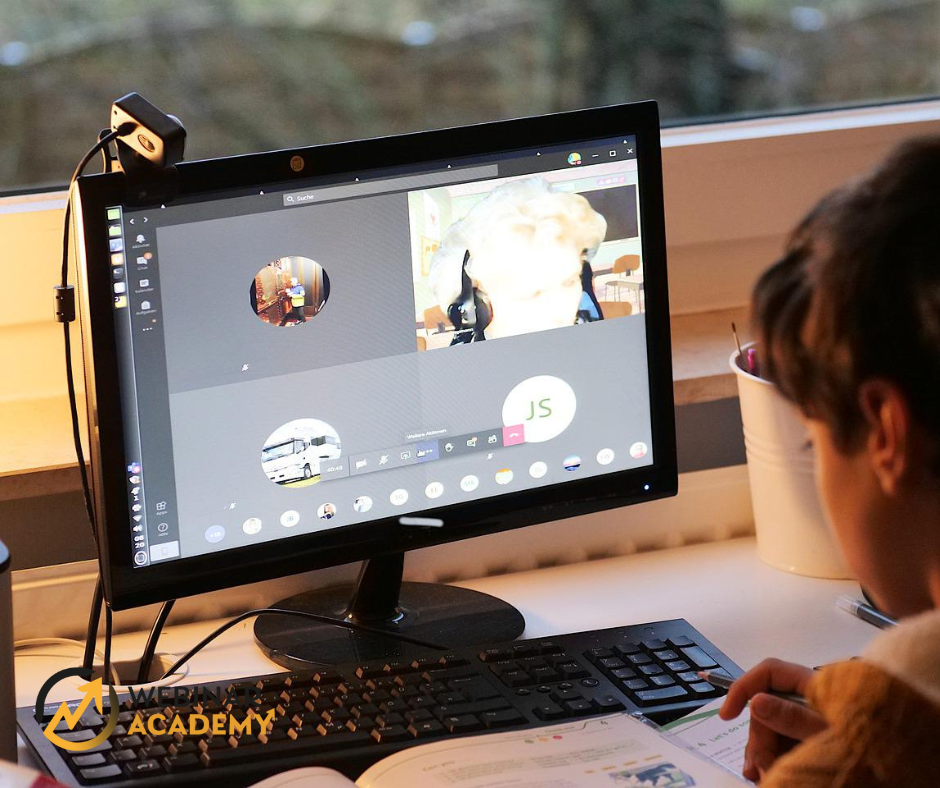Learning at school
One thing is best associated with learning - a classroom or lecture hall. At school, lessons were held in classrooms where the desks were almost always arranged in the same way - three rows, with a teacher's desk in front of them.
Everyone remembers the school days very well. Lessons consisted of lectures, a theoretical part, and sometimes, depending on the subject, a practical part followed. The lessons were conducted by the teacher, being physically in the classroom. Students participated in the class by answering, going up to the blackboard. There were unannounced question papers, announced tests. Many people were bored in theory because the knowledge was not imparted in an appropriately interesting way. Others, meanwhile, thought that after all, they could learn it themselves, sitting in their own homes, without having to get up in the morning and commute to the school building.
For a long time, however, no one imagined that this would ever be possible. School learning has always been unequivocally associated with sitting in a classroom - until pandemic times came along, which forced a change. School activities began to take place online. Students participated in lessons via programs that let them connect on video chat with other participants. Exercises were also carried out in this way, tasks were completed.
Stationary learning ... that is?
Stationary learning is the basic form of knowledge transfer. Its basic feature is that classes, lectures are held in a specific place. It can be a school, a university. It will always be a specific space where students and teacher - or teachers - gather. On-site learning is also characterized by the fact that most often a lecturer or trainer teaches a group of people. In school it is a class, in studies or courses - a group. Lessons, therefore, take place not only in a designated place, but also with other people. This is how classes have been taught in schools for a long time and will probably continue to be so for many years to come.

In the classroom, with others and with the teacher?
Classroom learning is considered the primary form of knowledge transfer. It has many advantages, but also drawbacks. It is not an ideal system - in fact, none is. Let's take a closer look at the advantages of stationary learning.
First and foremost, acquiring knowledge stationary involves the presence of a teacher on site. The teacher gives a lecture, but that is not where their role ends. If someone does not understand one of the issues, they can immediately ask about unclear issues, and the teacher will provide additional information. They will explain the problem, help to solve the task. Or perhaps develop a more interesting thread. The important thing is that the teacher is on the spot and responds in real time to what the group says and needs. Another issue is the presence of other people. It motivates learning and helps create an atmosphere conducive to acquiring knowledge. It's also worth noting that in a classroom full of students or learners, it's easier to ask a colleague for help or to repeat a point you didn't understand or didn't hear.
It is also important that classroom learning takes place in a specific place. In the classroom or hall there are props, teaching aids useful during the lesson. There is also a blackboard (most often) to help solve tasks. In addition, a specific place for learning promotes the right atmosphere. It prevents distractions. Being in the room, the student focuses on the subject of the class and can devote all, or at least most, of their attention to learning.
Among the disadvantages of classroom learning, one must certainly include the need to go to a given place and get up in the morning. Classes are held at specific times. It is therefore necessary to arrive at the classroom on time. Often the round trip commute takes several hours a day, especially during rush hour. For courses that are designed to develop skills, distance can be an obstacle. Sometimes the expansion of knowledge has to be abandoned because the course is too far away, in another city hundreds of kilometers away.
So there are many advantages, but also at least a few disadvantages of on-site learning. However, it is not the only form of knowledge intake.

Does it have a future?
Pandemic times have shown that stationary learning can be exchanged for remote learning and knowledge can be successfully transferred via the Internet. Does this mean that desktop learning is a relic of the past and its place will be taken by online classes, such as those organized by Webinar Academy? This platform relies on online knowledge transfer, which is convenient for many people.
This is certainly not the case. In the future, combined, hybrid models are likely to become popular. Some of the classes in, for example, studies or courses will be held on-site, stationary, and some in the form of e-learning - that is, via the Internet, for which a training platform is needed.
Such classes can take the form of real-time lectures, when participants join together in a lecture room at a certain time. They participate in the class through computer software and have cameras and microphones turned on. So they can actively participate in what is happening in the virtual classroom. They ask questions, answer the teacher, and solve assignments.
Another form of e-learning are courses created in advance. Students will find texts, video or audio materials in them. After getting acquainted with them, they fill out tests, perform tasks to consolidate the knowledge acquired in the theoretical part. The advantage of this form of learning is that the student can perform the lesson at any time, of course, fitting into the time limit set by the instructor.
However, they can do the tasks in the evening, in the morning or at night - whenever they have the time. They can also be anywhere with access to the web, since they don't have to run the camera or take an active part in the class.
Online courses such as the online training offered by Webinar Academy have many advantages. You will find knowledge on a variety of topics, many of which are sure to interest you. What's more, courses in the form of webinars can be replayed many times, repeating unclear issues and better assimilating the material. You will get down to studying when you have the time to do so, without a rigid hourly framework. Stationary learning is still considered the primary training model. Many courses are held only stationary, because trainers believe that by imparting knowledge face-to-face you can achieve better results. True, stationary learning has many advantages, but that doesn't mean you shouldn't take advantage of the conveniences of online access. Online courses save you time on commuting and you can redo them when you have the time.
